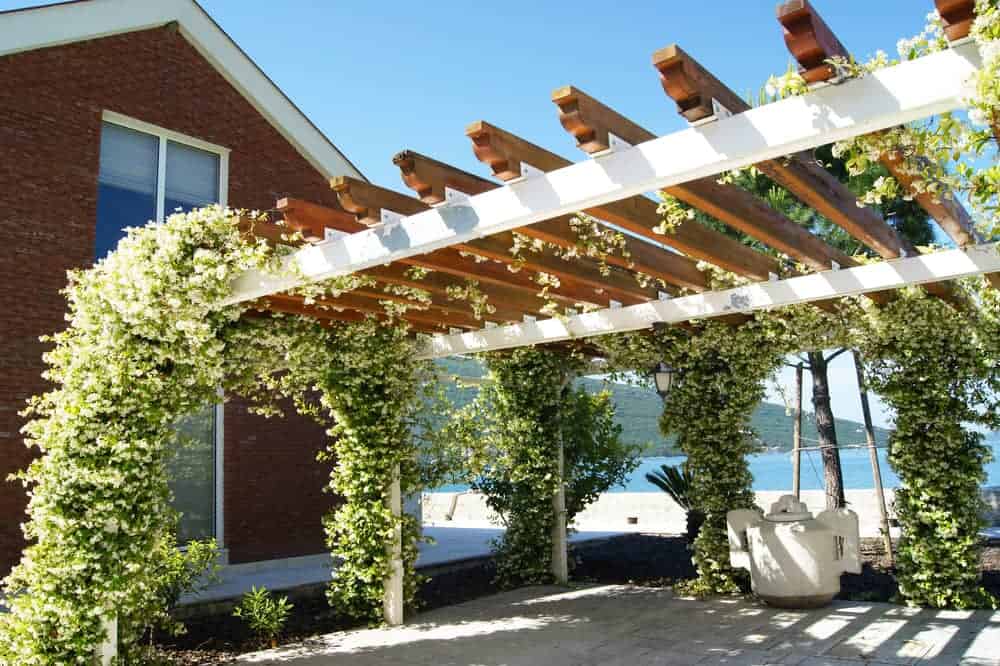Climbing plants can add a touch of romance to any garden. Whether climbing up archways or cascading over trellises, they make every space feel like a fairytale.
Now, if you need to fill up a wall or pergola quickly, look for fast-growing climbing plants. These will establish themselves and take over a structure within a few years, providing privacy, shade, or just a dreamy aesthetic.
Do you need to beautify a bit of bare brick in your backyard? Pick one of these fast-growing climbers and let them run wild — with proper pruning, of course!
List of Fast-Growing Climbing Plants
- Banksia rose
- Boston ivy
- Bower of Beauty
- Crimson glory vine
- Grape vine
- Hardenbergia
- Native jasmine
- Passionfruit vine
- Snake vine
- Sturt’s desert pea
- Wisteria
- Wonga wonga vine
Types of Climbing Plants
There are a few ways to categorise climbers, usually by how they climb up a surface. Some vines twist around a support, while others use hooks or thorns to “pull” their way upwards.
Match these climbing behaviours to the support structure available — for example, if your garden has a pergola, consider a tendril climber or twiner!
| TYPE | BEHAVIOUR | BEST FOR |
| Aerial rooters | Thick aerial roots that attach to vertical surfaces, such as large trees in the wild | Fences, walls, and large plants |
| Creepers | Vines that creep along the ground but may be trained to grow upwards | Trellises, pergolas, and stakes |
| Scramblers | Stems with thorns, hooks, or spikes that latch onto supports | Fences, pergolas, and walls |
| Sticky feet | Suction-like parts that stick to surfaces, which may damage painted or wooden surfaces | Trellises and walls |
| Tendril climbers | Small coils called tendrils, which emerge from stems or petioles and cling onto supports | Trellises, poles, and other thin supports |
| Twiners | Flexible stems that twist or twine around supports | Large trees and other thick supports |
Fast-Growing Climbing Plants for Australian Gardens
From flowering vines to evergreen twiners, we’ve put together a list of some of our top fast-growing climbers for Aussie homes.
These include native climbing plants, which are perfect for water-wise gardens!
Banksia rose
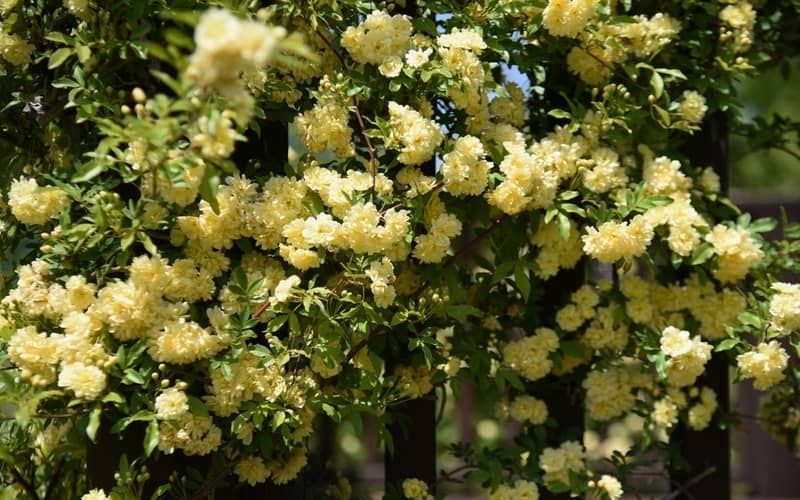
Type: Scrambler or twiner
Best for: Arches, pergolas, or screening
Mature size: Up to 9m in height and width
If you’re a big fan of climbing roses, you’ll love banksia roses (Rosa banksiae)! The small leaves and yellow or white flowers are breathtaking on an archway, trellis, or wall.
Banksia roses are evergreen in warm climates, but typically become semi-evergreen to deciduous in cooler regions.
In addition to being non-toxic climbing plants, R. banksiae varieties are mostly thornless. That makes the plant perfect if you have kids or pets running around the garden.
Don’t let the canopy of delicate flowers fool you, though! Banksia rose is a hardy plant — it tolerates full sun, is disease-resistant, and grows in most soils.
Boston ivy
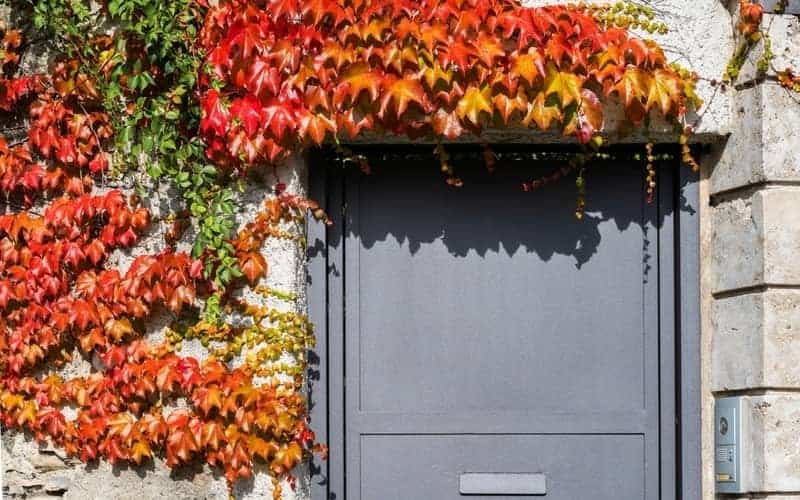
Type: Sticky feet
Best for: Pergolas, trellises, or walls
Mature size: Up to 10m height, 20m width
Despite the name, Boston ivy (Parthenocissus tricuspidata) isn’t a true ivy and isn’t even from Boston! Also called Japanese ivy, it’s a deciduous climber that’s related to grapes and comes from East Asia.
As it’s not a “true” ivy (Hedera genus), it’s not considered invasive — although it grows very quickly and can overwhelm trees if not pruned regularly. The plant climbs using sticky disks at the end of its tendrils.
Boston ivy has lush reddish-green to bronze leaves in the summer, which turn a vivid red to yellow-orange in autumn. These deciduous vines are ideal for trellises and walls that may not need cover year-round.
P. tricuspidata does best in full sun but can tolerate partial shade. Grow it in well-drained soil and do regular pruning in the summer so it doesn’t go wild.
Bower of Beauty
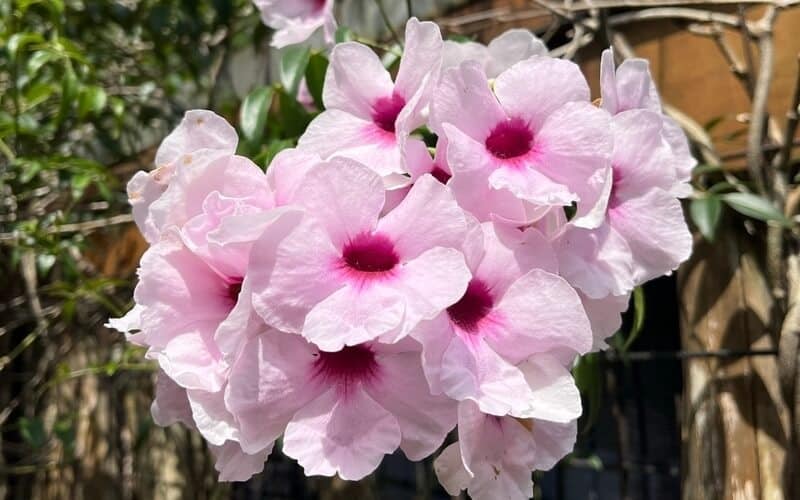
Type: Twiner
Best for: Fences or trellises
Mature size: Up to 5m with pruning
The Bower of Beauty (Pandorea jasminoides) is a gorgeous Australian native climbing plant! Also called Bower vine, it’s a hardy plant that can tolerate drought, shade, and even smog.
If grown in cold climates, such as Canberra, the Bower of Beauty will need shelter or protection.
The vines aren’t too dense, instead spreading gracefully to cover a space. In late spring to summer, you’ll get clusters of white or pink flowers shaped like trumpets!
Like many native climbers, Bower of Beauty prefers well-draining soil that’s slightly acidic. Plant it away from underground structures or sewage, as it has a robust and penetrating root system.
Crimson glory vine
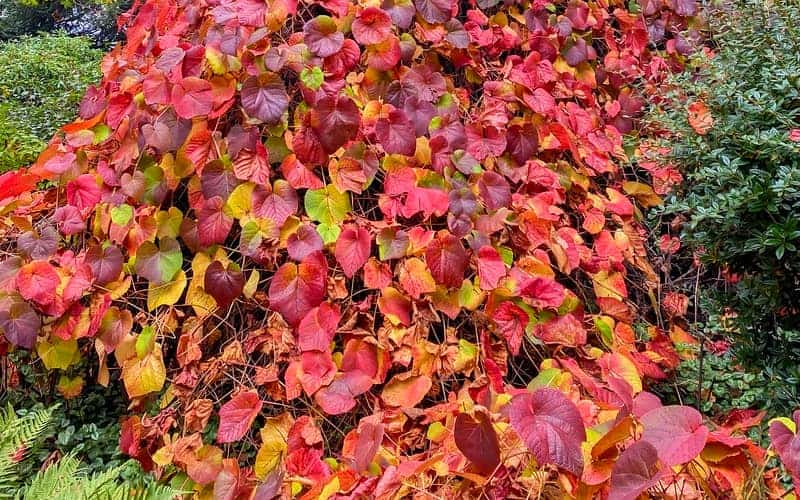
Type: Tendril climber
Best for: Pergolas, trellises, or walls
Mature size: Up to 15m height, 6m width
Crimson glory vines (Vitis coignetiae) are also related to grape vines, but they’re purely ornamental! Aussie gardeners love this climbing plant for its vivid autumn foliage, with shades of scarlet and purple.
The crimson glory vine is one of the best climbing plants for pergolas in Australia. Its dense growth habit will provide summer shade, before the leaves later drop to let in the winter sun.
V. coignetiae is a non-invasive climbing plant, but it needs hard winter pruning to maintain shape and size since it grows very quickly.
Besides that, it’s fairly low-maintenance, just needing full sun and well-drained soil.
Grape vine
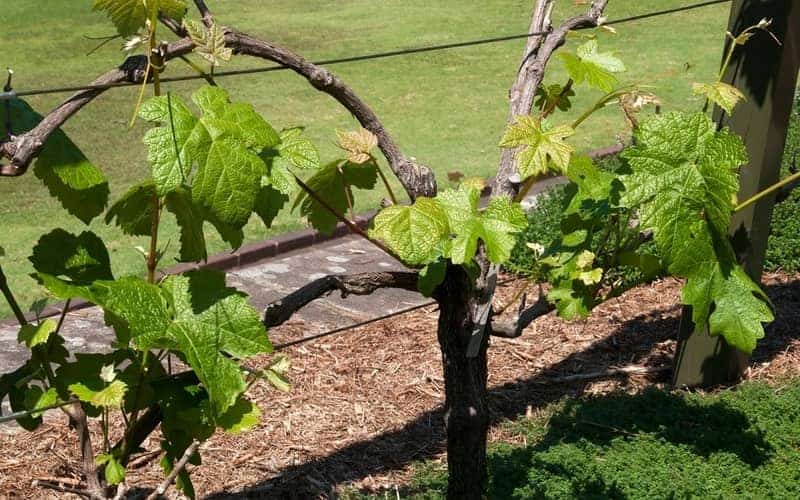
Type: Tendril climber
Best for: Fences or trellises
Mature size: Up to 9m in height and width
Vitis vinifera is the ‘mother’ of many domesticated grape vines, and the different varieties are used to make most wines around the world!
Don’t confuse it with the native grape ivy (Cissus hypoglauca), which is a different climbing plant.
V. vinifera vines are also great climbers for shade, thanks to their large leaves and dense growth. If you get a fruiting variety, it’ll need strong support, preferably with horizontal wires to hold the vines up.
Grape vines grow happily in a sunny position, with rich, well-draining soil that’s slightly alkaline. Do regular pruning in winter to prepare the plant for fruits in the summer.
Hardenbergia
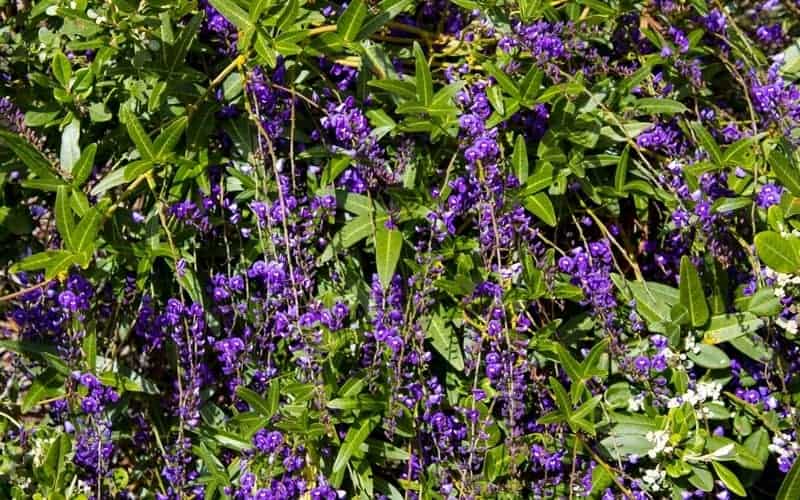
Type: Twiner
Best for: Fences, trellises, or screening
Mature size: Up to 2m in height and width
Looking for climbing plants with flowers in Australia? Try our native Hardenbergias — also known as purple coral pea, False Sarsaparilla, or native lilac.
The most popular species may be Hardenbergia violacea, which has cultivars like ‘Happy Wanderer’ (bright purple flowers) or ‘Alba’ (white flowers).
These low-maintenance, evergreen climbing plants feature dark green leaves in a narrow, pointed shape. They make a statement with masses of flowers in winter and spring.
Hardenbergias are adaptable plants and can grow in most soils if they have good drainage and lots of sunlight. They’re hardy ones established and can even tolerate light frost.
Native jasmine
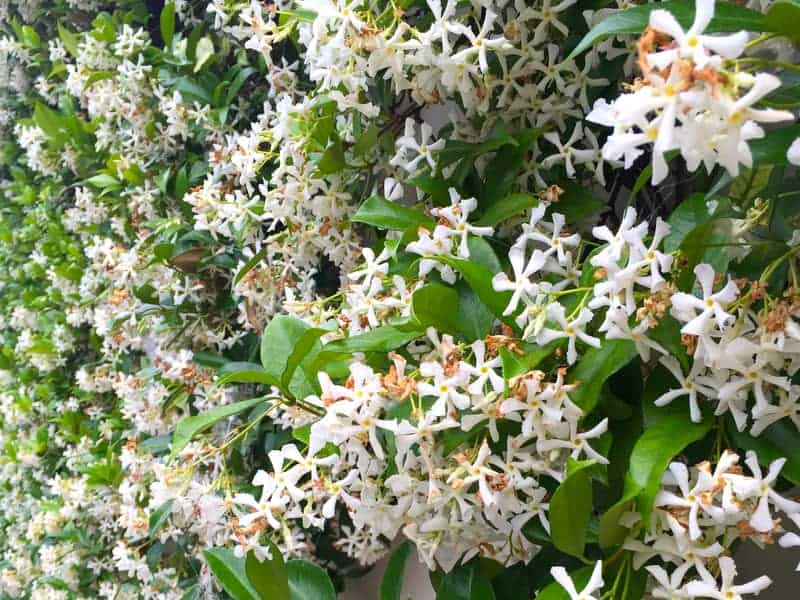
Type: Twiner
Best for: Fences, screening, or walls
Mature size: Up to 0.5m in height as a shrub
For a native alternative to star jasmine (Trachelospermum jasminoides), try our own Australian jasmine — Jasminum suavissimum!
Native jasmine has small, fragrant white flowers that bloom from late spring to early summer. It’s actually a shrub with vines that can grow upwards with support, so it’s the perfect climbing plant for fences.
J. suavissimum prefers full sun and can tolerate most soils if there’s good drainage. Keep it away from other plants, as the twining stems can take over if not controlled with pruning.
It can be tricky to find native jasmine, especially online, but we promise it’s worth the effort.
Passionfruit vines
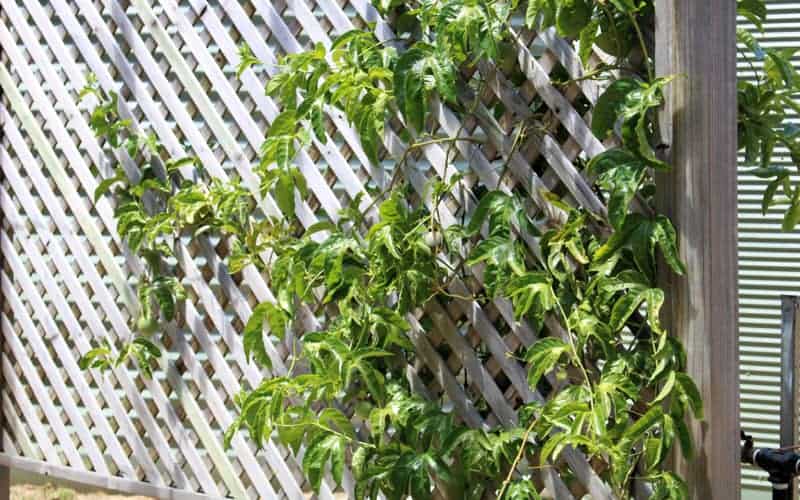
Type: Tendril climber
Best for: Pergolas, pots, or trellises
Mature size: Up to 7m height and 2.5m width
Yep, passion fruits grow from vines! Passionfruit vines are among the best climbing plants for pots, as they have extensive root systems. They can be trained to grow up trellises and other supports.
Be careful, though — certain grafted varieties of passionfruit vines are considered invasive or weedy. Avoid vines grafted with blue passionflower (Passiflora caerulea) or banana passionfruit (Passiflora tarminiana) in particular.
Some passionfruit vines we recommend for Aussie gardeners include Nellie Kelly and Panama Gold. Depending on variety and climate, the vines can take as quick as 6 months or as long as 18 months to bear fruit!
This evergreen climber loves the sun and warm climates. Grow it in rich, well-draining soil with a pH between 5.5 and 6.5.
Snake vine
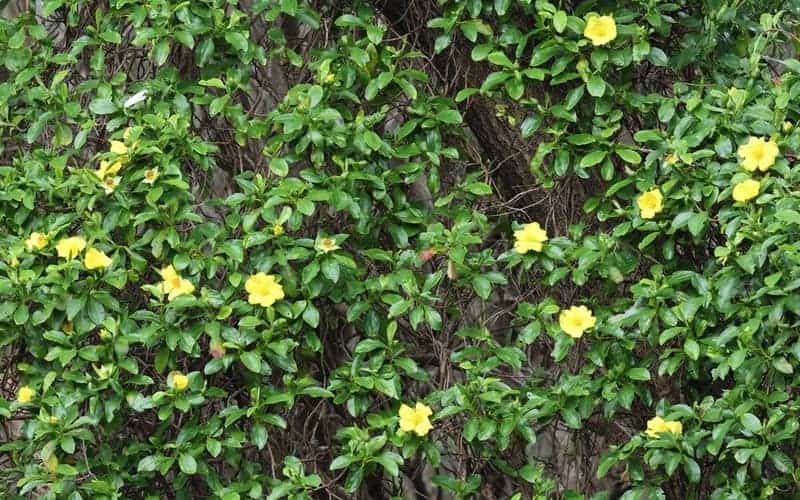
Type: Twiner
Best for: Fences or trellises
Mature size: Up to 9m in height and width
Hibbertia scandens is a popular fast-growing, evergreen climbing plant in Australia, and for good reason! Snake vines (or golden guinea vines) are hardy, adaptable, and water-wise.
In late spring and summer, the flowering vines feature cheerful yellow blooms. They’ll only last a day or two, but the plant can repeatedly flower over several months.
H. scandens is happiest in full sun, but tolerates partial shade. So long as the soil has good drainage, it can tolerate a wide range of conditions, including coastal climates or moderate frost.
Snake vines aren’t as vigorous as other fast-growing climbers, but can overwhelm nearby plants if not pruned regularly.
Sturt’s desert pea
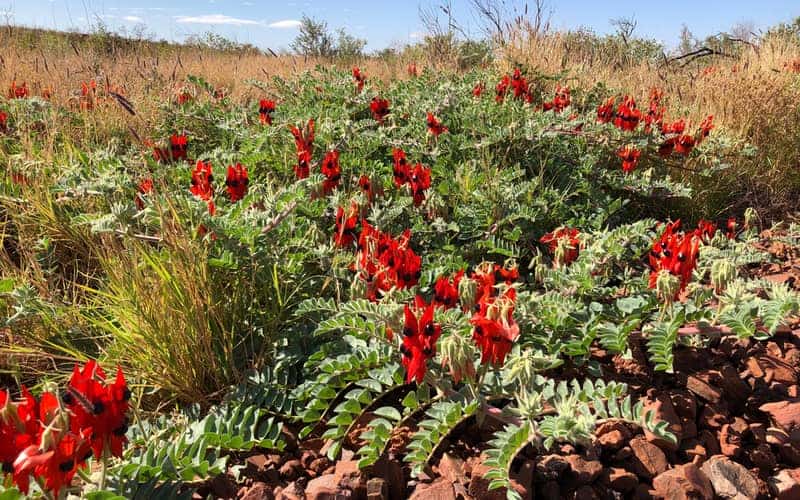
Type: Creeper
Best for: Stakes or trellises
Mature size: Up to 0.5m as a shrub
Many of us know and love this iconic native flowering plant — Sturt’s desert pea (Swainsona formosa). It’s not a natural climber, but it can be trained to grow upright on a support!
Sturt’s desert pea can be tricky to grow at home since it’s endemic to desert conditions. You’ll need to plant it in gritty potting mix with good drainage.
Don’t water the plant too often, as it’s prone to root rot and other fungal diseases. But if you can get it to thrive, those showy red flowers look amazing.
Wisteria
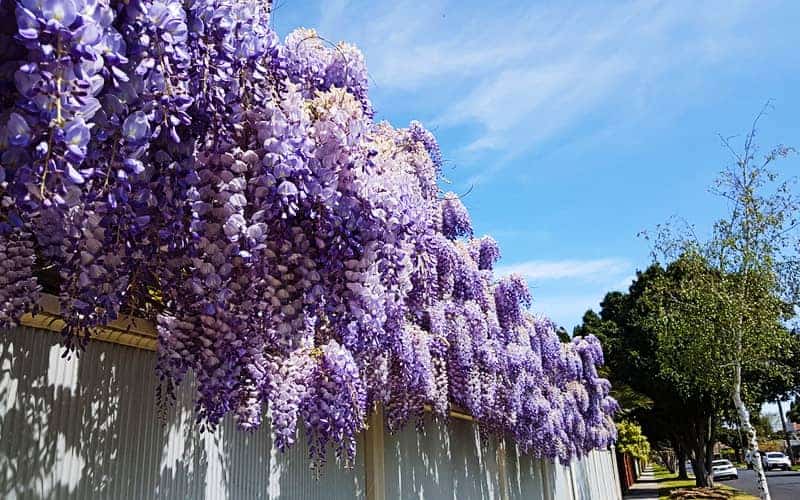
Type: Twiner
Best for: Arches, pergolas, or verandahs
Mature size: Up to 3m height and 2m width
Before anything else, make sure to choose a non-invasive wisteria variety. In Australia, your best option is Wisteria frutescens ‘Amethyst Falls’, which is less aggressive than other cultivars.
Avoid cultivars such as Wisteria sinensis or Wisteria floribunda, which are considered invasive in many regions of Australia. Check your local state or council regulations to be sure!
Wisteria Amethyst Falls is a frost-hardy climbing plant that prefers full sun and free-draining soil. The flowers are shorter-lived compared to other wisterias, but you’ll get multiple flushes throughout summer.
Keep in mind that W. frutescens goes dormant from autumn through winter, so don’t panic if it starts losing its leaves!
NOTE: For a native alternative, consider Hardenbergia comptoniana, which is nicknamed native wisteria.
Wonga wonga vine
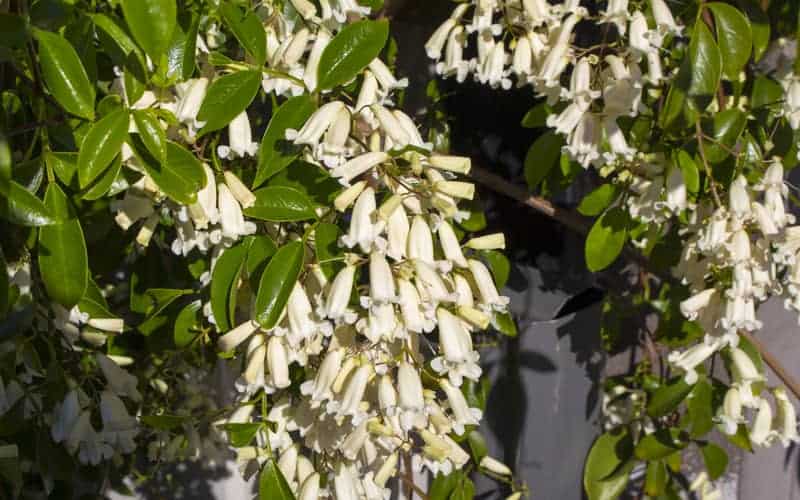
Type: Twiner
Best for: Most structures
Mature size: Up to 10m in height and width (with pruning)
For Australian native climbing plants that put on a show, look no further than the wonga wonga vine (Pandorea pandorana).
This fast-growing climber puts out colourful flowers in late winter or spring. The cascades of bell-shaped blooms come in pink, white, or even yellow.
Wonga wonga is an evergreen vine that’s adaptable to most soils and climates. Just give it lots of sun and good drainage, and it’ll thrive!
You’ll need to keep an eye on these climbing vines, though. They can get unruly without regular pruning, and should not be planted near underground sewer systems.
How to Care for Climbing Plants
With any fast-growing climbing plant, you’ll need to prune it regularly to maintain a good size and shape. Otherwise, it can get unruly — or even take over other plants in your garden.
If your plants are getting out of hand (or you just want some help), tag in a local pruning and gardening service!
Creepers, scramblers, tendril climbers, and twining climbers will need to be trained to grow upright! You can use gardening ties or plant clips to attach them to their support when they’re young.
Eventually, the plants will “grow into” their ideal shape and fill out their support structure.
For climbers with robust root systems, consider growing them in pots! They’ll still climb up just fine, but won’t spread out and take over your garden.

